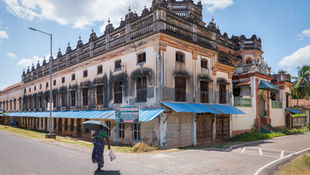Brick masonry is a structural technique in which the bricks are laid out in a systematic pattern and the joints are filled with mortar to make a solid structure. Some of the topics covered here include proper stacking, identifying high-quality bricks, and the importance of frog in bricks. Other factors to consider for the brickwork to last longer are also discussed.
Brickwork
Masonry structures are highly durable. Many historic buildings and engineering structures provide proof of this quality. If the masonry buildings are designed and built with competence and care, they should last much longer than their required life. The maintenance costs of masonry are quite minimal. A well-designed building will contain the majority of damage within the mortar and movement joints.

Stacking bricks
The following steps should be taken while stacking bricks.
Brick should not be dumped at the worksite.
Brick stacks should be close to the site of work so that the least effort is required to unload and transport the bricks again by loading on pallets or in barrows.
Bricks should be stacked on dry firm ground.
Identification of under-burnt bricks
If the bricks are soaked in water for a few hours, the half-burnt bricks will weather easily (the surface can easily be scratched with fingernails). Hence soaking the bricks for a minimum of one hour before using use will ensure that under-burnt bricks are not used for construction.

Characteristics of good quality bricks
Good bricks should be hard, sound, and well burnt
A brick should give a metallic ringing sound when struck with another brick or with a hammer.
Bricks should have uniform colour and fine compact texture.
When a brick is dropped from a height of one metre on another brick, it should not break.
The brick should not absorb water more than 20 percent of its own weight.
The bricks should be free from any water-soluble chlorides or sulphate. The source of salts could be from the soil or from the water used for brick making.
A good brick of 2 kg should not weigh more than 2.4 kg if immersed in water for 24 hours.
The need for a “Frog”
The indent or sinking in the brick is termed a frog. Some bricks have no indent or frog at all, some have on one face only and some have indents on both long faces. They are formed to facilitate the bedding of bricks in mortar. All bricks should be placed with their frogs on top so as to provide good bonding with mortar.

Brickwork: Points to remember
There are a lot of things to consider to produce good brickwork. Some of the main points to be kept in mind are the following;
Bricks required for masonry in cement should be thoroughly soaked in clean water for not less than an hour before use.
At the time of laying, the bricks should not be too wet.
All the walls should be taken truly vertical. The courses should be laid horizontal and vertical joints in two adjacent courses should be avoided.
Bricks with frogs should be laid with frogs upwards.
Mortar should be pressed into all the vertical joints using a trowel. Properly filled joints ensure maximum strength and resistance to penetration of moisture which takes place mainly through joints.
When new brickwork is started, the surface over which the brickwork is to be started should be slightly wetted.
When the brickwork is to be plastered, the surface should be raked out to a depth of 12-15 mm. so as to give an adequate key for plastering.
The thickness of a mortar joint should not be more than 12 mm.
Broken bricks should not be used unless they are essential from a good-bond point of view.
In the case of brick masonry, the wall should be constructed to a height of not more than one metre per day.
The brickwork should be cured for a minimum period of seven days.
The verticality of walls and horizontality of the courses should be checked frequently with plumb bob and spirit level respectively.
Bricks are soaked in water before use for the following reasons;
The brick should not draw/absorb the water from the mortar.
By soaking bricks in water, under-burnt bricks can be identified.
The appearance of a white patch on the surface of the brick indicates the presence of water-soluble salts in the brick.

Broken bricks should be used where it is necessary for bonding. The common habit among the masons is to break one full brick even when many half bricks are available. This kind of wastage can be avoided.
Brickwork Mortar and its Thickness
Mortar should be properly filled in between the bricks and at each joint (Vertical and Horizontal). The thickness of the mortar should not exceed 12-18 mm (½ -¾ inch). The greater the thickness of mortar, the weaker the strength of the brickwork.

The blog goes over brickwork in great detail and the considerations that should be made while doing it. The importance of choosing and identifying quality bricks, as well as their stacking, is also mentioned in detail. The brickwork structure will live longer than its planned lifespan if it is designed with care.














